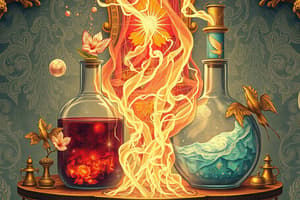Podcast
Questions and Answers
What occurs when an endothermic reaction is cooled?
What occurs when an endothermic reaction is cooled?
- The equilibrium shifts to the right, favoring product formation.
- The equilibrium shifts to the left, favoring reactant formation while releasing energy. (correct)
- The equilibrium shifts to the left, favoring energy absorption.
- The equilibrium remains unchanged due to temperature having no direct impact.
For a gas in a mixture, what is the definition of its partial pressure?
For a gas in a mixture, what is the definition of its partial pressure?
- The pressure of the gas when the system is in equilibrium.
- The pressure exerted by all gases in the mixture.
- The total pressure of the gas mixture.
- The pressure of the gas if it alone occupied the mixture's volume. (correct)
Which of the following will NOT alter the equilibrium position of a reaction?
Which of the following will NOT alter the equilibrium position of a reaction?
- Adding an inert gas to a closed system with constant volume.
- Changing the state of a reactant in a system.
- Adding a catalyst to the reacting system. (correct)
- Increasing the concentration of a reactant.
An aqueous reaction system also contains a solid precipitate. Which of the following will affect the equilibrium?
An aqueous reaction system also contains a solid precipitate. Which of the following will affect the equilibrium?
What does the reaction quotient (Q) represent?
What does the reaction quotient (Q) represent?
Which statement accurately describes the rate-determining step in a reaction mechanism?
Which statement accurately describes the rate-determining step in a reaction mechanism?
What is a reaction intermediate?
What is a reaction intermediate?
What is the primary characteristic of instantaneous concentrations?
What is the primary characteristic of instantaneous concentrations?
Which of the following is a characteristic of elementary steps involving a single reactant?
Which of the following is a characteristic of elementary steps involving a single reactant?
How does a chemical equilibrium system respond to the absence of a reactant or product?
How does a chemical equilibrium system respond to the absence of a reactant or product?
What condition defines a solubility equilibrium in a solution?
What condition defines a solubility equilibrium in a solution?
Why are elementary steps involving three reactant molecules very rare?
Why are elementary steps involving three reactant molecules very rare?
How is the rate law determined for elementary reaction steps?
How is the rate law determined for elementary reaction steps?
Which of the following statements is true about solubility at equilibrium?
Which of the following statements is true about solubility at equilibrium?
How is the order of the rate law determined for the elementary steps?
How is the order of the rate law determined for the elementary steps?
Which term describes the dynamic equilibrium between a solid ionic compound and its dissolved ions in a saturated solution?
Which term describes the dynamic equilibrium between a solid ionic compound and its dissolved ions in a saturated solution?
Which of the following must be true for a reaction mechanism to be considered plausible?
Which of the following must be true for a reaction mechanism to be considered plausible?
What does the solubility product constant represent for a saturated solution?
What does the solubility product constant represent for a saturated solution?
What defines a system to be in a state of chemical equilibrium?
What defines a system to be in a state of chemical equilibrium?
How does the charge of ions typically affect the solubility of an ionic compound?
How does the charge of ions typically affect the solubility of an ionic compound?
What distinguishes the solubility of an ionic compound from its solubility product constant?
What distinguishes the solubility of an ionic compound from its solubility product constant?
Which of the following describes a strong acid in an aqueous solution?
Which of the following describes a strong acid in an aqueous solution?
What is the relationship between the strength of an acid and its conjugate base?
What is the relationship between the strength of an acid and its conjugate base?
Which of the following is a characteristic of a weak base?
Which of the following is a characteristic of a weak base?
What effect does increasing the surface area of a solid reactant typically have on a chemical reaction?
What effect does increasing the surface area of a solid reactant typically have on a chemical reaction?
What is the autoionization of water?
What is the autoionization of water?
Which of the following best describes how a catalyst increases the rate of a reaction?
Which of the following best describes how a catalyst increases the rate of a reaction?
What is the value of the ion-product constant for water (Kw) at 25 degrees C?
What is the value of the ion-product constant for water (Kw) at 25 degrees C?
In a chemical reaction, what does the term 'rate law' refer to?
In a chemical reaction, what does the term 'rate law' refer to?
What is the relationship between Ka, Kb and Kw?
What is the relationship between Ka, Kb and Kw?
What is the significance of the rate constant (k) in a chemical reaction?
What is the significance of the rate constant (k) in a chemical reaction?
What happens to the hydrogen ion concentration when a base is added to pure water?
What happens to the hydrogen ion concentration when a base is added to pure water?
What does the 'order of reaction' with respect to a reactant indicate?
What does the 'order of reaction' with respect to a reactant indicate?
Which of the following is NOT true about group 1 and group 2 hydroxides?
Which of the following is NOT true about group 1 and group 2 hydroxides?
What is the definition of an elementary step in a reaction mechanism?
What is the definition of an elementary step in a reaction mechanism?
Which of the following best describes a reaction mechanism?
Which of the following best describes a reaction mechanism?
Why do complex molecules with complex bonds usually require more energy to react?
Why do complex molecules with complex bonds usually require more energy to react?
What characterizes a system at dynamic equilibrium?
What characterizes a system at dynamic equilibrium?
What determines the equilibrium position in a reversible chemical reaction?
What determines the equilibrium position in a reversible chemical reaction?
If a reversible reaction starts with only reactants, what occurs as it approaches equilibrium?
If a reversible reaction starts with only reactants, what occurs as it approaches equilibrium?
What aspect of a chemical reaction will NOT affect the value of the equilibrium constant (K)?
What aspect of a chemical reaction will NOT affect the value of the equilibrium constant (K)?
How are the equilibrium constants of a forward reaction and its reverse reaction related?
How are the equilibrium constants of a forward reaction and its reverse reaction related?
If the equilibrium constant (K) for a reaction is very large, what can be inferred about the equilibrium position?
If the equilibrium constant (K) for a reaction is very large, what can be inferred about the equilibrium position?
What is a homogeneous equilibrium?
What is a homogeneous equilibrium?
If the rate constant (k) for the forward reaction is equal to $k_f$ and the rate constant (k) of the reverse reaction is equal to $k_r$, what is the equilibrium constant (K)?
If the rate constant (k) for the forward reaction is equal to $k_f$ and the rate constant (k) of the reverse reaction is equal to $k_r$, what is the equilibrium constant (K)?
Flashcards
Bond breaking vs. ion combination
Bond breaking vs. ion combination
Reactions that require breaking existing bonds before forming new ones need more energy than reactions involving ion combination.
Complexity and reactivity
Complexity and reactivity
Complex molecules with intricate bonds have higher activation energy and are less reactive due to their stable structure.
Concentration and reaction rate
Concentration and reaction rate
Increasing reactant concentrations leads to more frequent collisions, increasing the likelihood of effective collisions and faster reaction rates.
Surface area and reaction rate
Surface area and reaction rate
Signup and view all the flashcards
Catalyst and reaction rate
Catalyst and reaction rate
Signup and view all the flashcards
Chemical rate law
Chemical rate law
Signup and view all the flashcards
Order of reaction
Order of reaction
Signup and view all the flashcards
Elementary step
Elementary step
Signup and view all the flashcards
Rate-Determining Step
Rate-Determining Step
Signup and view all the flashcards
Reaction Intermediate
Reaction Intermediate
Signup and view all the flashcards
Elementary Step with 1 Reactant
Elementary Step with 1 Reactant
Signup and view all the flashcards
Elementary Step with 3 Reactants
Elementary Step with 3 Reactants
Signup and view all the flashcards
Chemical Equilibrium
Chemical Equilibrium
Signup and view all the flashcards
Plausible Reaction Mechanism
Plausible Reaction Mechanism
Signup and view all the flashcards
Rate Law for Elementary Steps
Rate Law for Elementary Steps
Signup and view all the flashcards
Dynamic Equilibrium
Dynamic Equilibrium
Signup and view all the flashcards
Equilibrium Position
Equilibrium Position
Signup and view all the flashcards
Reversible Reaction
Reversible Reaction
Signup and view all the flashcards
Equilibrium Constant (K)
Equilibrium Constant (K)
Signup and view all the flashcards
Equilibrium Constant: Temperature and Concentration Dependence
Equilibrium Constant: Temperature and Concentration Dependence
Signup and view all the flashcards
Homogeneous Equilibrium
Homogeneous Equilibrium
Signup and view all the flashcards
Predicting Equilibrium Position using K
Predicting Equilibrium Position using K
Signup and view all the flashcards
Le Chatelier's Principle
Le Chatelier's Principle
Signup and view all the flashcards
Reciprocal Relationship of K and K'
Reciprocal Relationship of K and K'
Signup and view all the flashcards
Temperature Change Effect on Equilibrium
Temperature Change Effect on Equilibrium
Signup and view all the flashcards
Partial Pressure
Partial Pressure
Signup and view all the flashcards
Instantaneous Concentrations
Instantaneous Concentrations
Signup and view all the flashcards
Solubility
Solubility
Signup and view all the flashcards
Solubility Equilibrium
Solubility Equilibrium
Signup and view all the flashcards
Solubility Product Constant (Ksp)
Solubility Product Constant (Ksp)
Signup and view all the flashcards
Solubility and Ion Charge
Solubility and Ion Charge
Signup and view all the flashcards
Solubility of an Ionic Compound
Solubility of an Ionic Compound
Signup and view all the flashcards
Dynamic Equilibrium in Precipitation Reactions
Dynamic Equilibrium in Precipitation Reactions
Signup and view all the flashcards
Amphiprotic
Amphiprotic
Signup and view all the flashcards
Brønsted-Lowry Acid
Brønsted-Lowry Acid
Signup and view all the flashcards
Brønsted-Lowry Base
Brønsted-Lowry Base
Signup and view all the flashcards
Acid Dissociation Constant (Ka)
Acid Dissociation Constant (Ka)
Signup and view all the flashcards
Acid Strength and Conjugate Base Strength
Acid Strength and Conjugate Base Strength
Signup and view all the flashcards
Ion-Product Constant for Water (Kw)
Ion-Product Constant for Water (Kw)
Signup and view all the flashcards
pH
pH
Signup and view all the flashcards
pH Meter
pH Meter
Signup and view all the flashcards
Study Notes
5.2 Chemical Notes
-
Specific Heat Capacity: the quantity of thermal energy needed to raise the temperature of 1 gram of a substance by 1°C.
-
Different substances have different heat capacities.
-
High heat capacities mean more time to cool down
-
Calorimetry is the experimental measurement of thermal energy changes in chemical or physical changes.
-
Enthalpy is the total thermal energy in a substance.
-
Enthalpy change is the energy change in a system during a reaction.
-
For constant pressure, enthalpy change (ΔH) = energy change in the system
-
The molar enthalpy change of a chemical reaction is the energy change when one mole of a substance undergoes a physical or chemical change.
5.3 Textbook Notes
- Bond dissociation energy is the energy needed to break a chemical bond (always positive).
- For example, breaking a C-H bond requires 413 kJ of energy per mole.
- Bond energy increases with the number of bonds between atoms (e.g., triple bonds require more energy than single bonds).
- To calculate the enthalpy change of a reaction using bond energies: first calculate the energy needed to break all bonds in the reactants. Then calculate the energy needed to form all bonds in the products. The difference between these two sums is the enthalpy change of the reaction.
5.4 Textbook Notes
- Enthalpy change in a chemical process doesn't depend on the path taken.
- The enthalpy change for converting reactants to products will be the same regardless of the pathway.
- Hess's Law: The enthalpy change for a reaction is the same whether the reaction occurs in one step or in multiple steps. -If you reverse a reaction, you must also reverse the sign of ΔH. -If you multiply the coefficients in a balanced equation by a certain factor, the enthalpy change must also be multiplied by the same factor.
- Energy cannot be created or destroyed, but it can be converted from one form to another and transferred between a system and its surroundings. Hess's Law supports this energy conservation principle.
5.5 Textbook Notes
- Standard enthalpy of formation: the enthalpy change when 1 mole of a compound is formed from its elements, with all substances in their standard state.
- Standard state: the most stable form of a substance at standard pressure and temperature.
6.1 Notes
- Chemical kinetics is the study of reaction rates.
- Reaction rate is a measurement of how quickly reactants are converted to products per unit time.
- Reaction rates can be measured different ways (e.g., gas production rate, color change, pH, gas volume).
- The average reaction rate is the change in concentration of a reactant or product over a time period.
- A negative sign in reaction rate formulas indicates consumption of a reactant, and a positive sign indicates formation of a product.
6.2 Notes
- Chemical properties describe how a substance behaves when it undergoes a chemical reaction.
- Rate of a reaction is often affected by reactant concentration. Greater concentration of reactants leads to more collisions and a faster rate.
- Reaction rate generally increases with temperature.
- Catalysts speed up reactions without being changed themselves. Homogeneous catalysts are in the same phase as reactants, while heterogeneous catalysts are in a different phase.
6.3 Notes
- The collision theory suggests reactions occur when reactant particles collide with sufficient energy and proper orientation.
- Effective collisions lead to products.
- Reaction rates depend directly on the frequency of effective collisions.
- Activation energy is the minimum energy required for a collision to be effective.
6.5 Notes
- Rate laws are equations showing the relationship between a reaction rate and reactant concentrations.
- Initial concentrations are used to determine rate constants.
- Rate constants are specific to each reaction and vary with temperature.
- Reaction orders are determined experimentally and correlate with the exponents and relationships between the rate, the rate constant, and the initial reactant concentrations
- Reaction mechanisms are the series of elementary steps involved in a reaction. Elementary steps involve one, two, or three particles colliding.
- Rate-determining steps are the slowest elementary steps, which determine overall reaction rate.
7.1 Notes
- Chemical Equilibrium is the state where the rate of the forward reaction equals the rate of the reverse reaction, and thus, concentrations of reactants and products become constant.
- Equilibrium is dynamic; forward and reverse reactions continue, but at equal rates.
- Equilibrium occurs only in a closed system.
- Equilibrium positions are defined by relative concentration of reactants to products.
- Equilibrium can be shifted from forward to reverse.
7.2 Notes
-
Equilibrium constant (K): it's a constant numerical value for any given reaction at a particular temperature.
-
Homogeneous equilibrium: all reactants and products are in the same state (e.g., gas).
-
Heterogeneous equilibrium: reactants and products are in different states (e.g., solid, liquid, gas).
-
In heterogeneous systems, pure solids and pure liquids are not included in the expression of K.
7.4 Notes
- Le Chatelier's Principle: if an equilibrium system is stressed, it shifts in the direction that relieves the stress. Stress can be: changing concentration, changing temperature, or changing pressure.
- Increasing reactant or decreasing product concentrations shifts equilibrium to the right.
8.1 Notes
- Acids are substances that increase hydrogen ion (H+) concentration in water.
- Bases are substances that increase hydroxide ion (OH−) concentration in water.
- The Brønsted-Lowry theory defines acids as proton donors and bases as proton acceptors.
- Conjugate acid-base pairs differ by a single proton.
8.2 Notes
- Strong acids ionize completely in water, whereas weak acids only partially ionize.
- Strong bases completely dissociate to hydroxide ions in aqueous solutions. Weak bases only partially react with water.
- Autoionization of water: water molecules react with each other to produce hydronium and hydroxide ions. Kw = [H+][OH−] = 1.0 × 10⁻¹⁴ at 25°C.
Studying That Suits You
Use AI to generate personalized quizzes and flashcards to suit your learning preferences.




